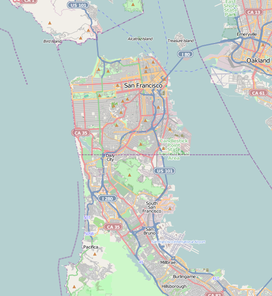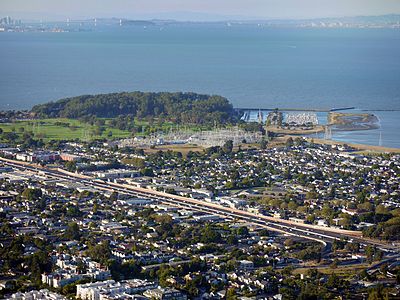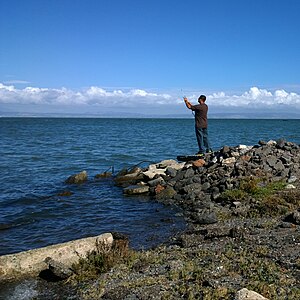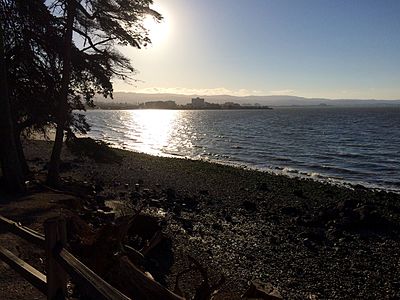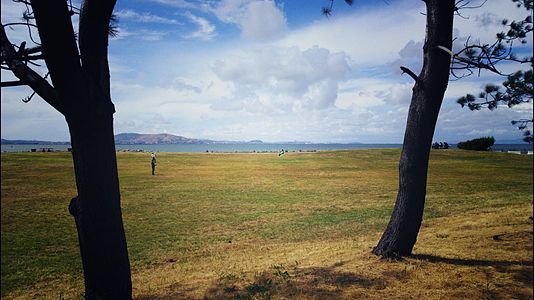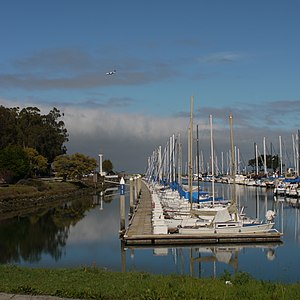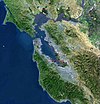Coyote Point Recreation Area
| Coyote Point Recreation Area | |
|---|---|
 Coyote Point from the air. Peninsula Avenue retreats into the center background after crossing the Bayshore Freeway (US 101), which runs from left to right in the upper portion of the picture. The marina, at lower left, runs almost directly north-south. Beyond the trees, in the upper left, is the adjoining Poplar Creek Golf Course. | |
| Type | Parkland, woodland, museum & zoo |
| Location | San Mateo County, California, USA |
| Coordinates | 37°35′22″N 122°19′34″W / 37.5893796°N 122.3260810°W |
| Area | 670 acres (270 ha)[1] |
| Created | 1962 |
| Operated by | San Mateo County, California |
| Open | All year |
Coyote Point Recreation Area is a 670-acre (270 ha) park in San Mateo County, California, United States. Located on San Francisco Bay, it is south of San Francisco International Airport on the border of Burlingame and San Mateo.
The distinctive point, covered by a grove of eucalyptus trees, can be seen from airplanes approaching San Francisco International Airport and is a good location for aircraft spotting and birdwatching.[1][2][3]
History

Precolumbian
Coyote Point was originally an island in San Francisco Bay with a marsh connecting it to the mainland. Because it has no fresh water, it is doubtful that Native Americans lived here, but shell mounds on the point indicate that it was at least occasionally used, possibly for special ceremonies or feasts.[4]
Spanish settlement

Coyote Point was part of the Presidio and Mission lands until it passed to Mexico. The Governor of Mexico then granted the land to Coyetano Arenas, to which the name can probably be traced. The Arenas family sold it to the firm of Mellus and Howard, and Howard purchased it from the firm in 1850. The land remained in the Howard family until it was sold to the county and the federal government in 1942.[4]
In the late 19th century, the Howard family built a pier at Coyote Point for lumber loading. They also reclaimed the marsh between the island and the mainland (now a golf course) to create dairy pasture. They built a bathhouse and pool on the beach in 1880, and had Eucalyptus, Cypress and Pine trees planted on the knoll.[4]
Pacific City Amusement Park
On July 1, 1922, a group of promoters opened the "Pacific City Amusement Park", which occupied approximately 90 acres (36 ha) along the beach leased from the Howard family.[5] Dubbed the "Coney Island of the West", the park included a beach (with trucked-in sand), boardwalk, children's playground, scenic railway, merry-go-round, Ferris wheel, dancing pavilion, and several food concessions.[4] A crowd estimated at more than 100,000 people visited Pacific City on July 4 of that year, drawing comparisons to Atlantic City.[6]
Although it was reputed to have had one million visitors in aggregate over the first season (1922), a fire during the second season destroyed about one quarter of the development, and it opened only briefly for a third season. The reasons given for the closure were strong afternoon winds and sewage contamination in the bay.[4]
Genesis

The name and site were first proposed in September 1921 at San Mateo City Hall by Nat Messer, a San Francisco real estate dealer who pitched the idea to the Three Cities Chamber of Commerce (3CCC).[7] The Pacific City Corporation (PCC), which developed the site, was led by a three-member board of directors composed of A.H. Dougall, Jr.; Arnold C. Lackenbach; and David J. Stollery.[8] Stollery was serving as the secretary for PCC's largest creditor, the William H. Howard Estate Company.[9] PCC was supported by the 3CCC, led by manager Daniel C. Imboden for the cities of San Mateo, Burlingame, and Hillsborough; 3CCC had been organized in 1921 with one of its stated priorities to be "the development of the San Mateo Beach" and was satisfied "that the building of Pacific City would well repay the membership of the Chamber for the money and time expended." At the time, the planned opening date was May 30, 1922, Decoration Day.[10]
The land was acquired for US$200,000 (equivalent to $3,640,000 in 2023) from the William H. Howard Estate Company in February 1922;[11][12] at the time, it was the largest real estate transaction in San Mateo County.[13] The site of Pacific City stretched for 3,000 ft (910 m) north from Coyote Point, including 90 acres (36 ha) of land and 250 acres (100 ha) covered by water.[11] The Pacific City Corporation bragged in April 1922 that an investment of US$473,000 (equivalent to $8,610,000 in 2023) in total had been made so far, including land, construction, and equipment.[12]
By late May, it was clear the new park would not be open in time for the holiday, although the work was nearing completion, including a 60 ft-high (18 m) entry gate with an illuminated sign, which would be visible to cars traveling on the Bayshore Highway.[14] D. Wooster Taylor resigned from his position as superintendent of the children's playground at Golden Gate Park (now the Koret Children's Quarter) to manage Pacific City.[15]
Attractions
Visitors to Pacific City rode the Southern Pacific Peninsula Commute trains to Burlingame, where shuttles would take them to the park for an additional 5 cents, or the ferry from San Francisco, which tied up at the old lumber pier built by the Howard family. Parking for automobiles was also provided.
In addition to regular live music performances, visitors could ride The Whip, Dodg-em cars, a Dentzel menagerie carousel, a 22-inch narrow-gauge railway, a Ferris wheel, or a "scenic railroad" roller coaster called The Comet,[16] which included an 80 ft (24 m) drop and was billed as the largest, fastest coaster west of Detroit. Visitors could choose from bathing on the beach or dancing in a large wooden pavilion; hunger was satiated by concessionaires vending hot dogs and pigs-in-the-blanket.
Financial peril
The first signs of financial ill-health began in September 1922, when PCC was sued over the failure to pay back a small promisorry note.[17] In December 1922, the Howard Estate filed suit to foreclose on the property over non-payment of a US$90,000 promissory note that had been signed by Dougall and Lackenbach; the first payment of $5,000, due the previous March 22, had not been made as scheduled and the only payment that had been received was $1,000 the preceding October.[18] 3CCC brokered an agreement in which a three-member committee was appointed to investigate and report on the financial status of PCC in February 1923; 3CCC President John J. McGrath, who was one of the appointees, warned "that we will not stand for one local creditor or stockholder in Pacific City to lose a penny ... if they jockey and humbug, we are in position to make their investment worth about ten cents [on the dollar]."[19] Lackenbach fired back days later: "... you have unwittingly placed the management of Pacific City in a very unfavorable light by reason of this article. It is not only unjust, but has absolutely no foundation. The management of Pacific City has at all times strenuously held that any reorganization or refinancing of Pacific City must first contemplate the payment of creditors in full with interest from the maturity of their claims."[20]
To calm the situation, 3CCC stated they supported both the Howard Estate and PCCC, but if the foreclosure suit was successful, it would antagonize many investors, who likely would lose their stakes.[21] The resort opened on May 19, 1923,[22][23] due in part to the uncertainty about the resort's future.
By late March 1924, the creditors of Pacific City had assumed control and announced the company would be reorganized under the leadership of Edmond Levy.[24] Plans were made to open the resort on July 1, 1924,[25] but the opening was delayed until July 4.[26] Admission to the park itself was made free that year, with a small fee for automobile parking.[27] In March 1925, San Mateo County Superior Court Judge George H. Buck granted the Howard Estate's foreclosure petition, forcing the site to liquidate its assets.[28]
Legacy
The carousel which operated there, as well as the "little puffer" miniature train ride, can still be enjoyed at the San Francisco Zoo.[29] The Dentzel Carousel Company built the menagerie carousel for Pacific City, and it was moved to what was then Fleishhacker Zoo in 1925; it has since undergone restoration in 1978, 1994, and 2000.[30] Historians have traced the train back to a class built and operated originally at the 1904 Louisiana Purchase Exposition by the Miniature Railway Company. This particular train was known to have run along the Santa Cruz Beach Boardwalk as the Bay Shore Limited between 1907 and 1915[31] before it was sold for scrap to a Ford dealer in San Francisco. After running at Pacific City, it was hidden in Burlingame for two years to avoid being impounded, then sold to Herbert Fleishhacker for his eponymous zoo in 1925.[32]
The Pacific City beach is known presently as the Coyote Point Promenade. Rehabilitation of the beach is being performed in two phases; the first phase, covering the western half, was completed in 2014 and rebuilt the portion of the San Francisco Bay Trail that ran along the shoreline, along with placing rock revetment to protect the trail and rebuilding the public access ramps to the Bay.[33] The second phase is scheduled to be completed in spring 2022, and will include parking reconfiguration and a new beach.[34] During the eastern promenade work, the remnants of 35 wooden piers that once supported the Pacific City Boardwalk were removed, as they posed a tripping hazard to beachgoers.[35]: 9, 12
Educational use
In 1942, the federal government purchased 10 acres (4.0 ha) of land on Coyote Point for one of three Merchant Marine Cadet Basic schools, the Pacific Coast Cadet Corps (the other two were for the Atlantic Coast Cadet Corps at Kings Point, New York and the Gulf Coast Cadet Corps at Pass Christian, Mississippi).[36] The merchant marine training program had been shortened from 48 to 18 months, in three stages:[37]
- Basic School (lasting 3 months, serving as Fourth Class Cadet-Midshipmen at Kings Point, San Mateo, or Pass Christian)
- Shipboard experience (6 months, Third Class aboard merchant vessels)
- Academy (9 months, Second and First Class at Kings Point)
The Pacific Coast Merchant Marine Cadet Basic School had started aboard the ex-riverboat Delta Queen on 1 July 1941; enrollment quickly outgrew the ship, and the school moved to land-based facilities on Treasure Island.[38] With the outbreak of war, enrollment exceeded the capacity of facilities on Treasure Island and US$450,000 (equivalent to $8,391,000 in 2023) was appropriated to enlarge the school in May 1942.[38] Plans were swiftly drawn up by Cdr. Ralph M. Sheaf, and construction began on the facilities at Coyote Point on June 25, 1942.[38] The Basic School opened on August 15, 1942 and was officially dedicated on August 21, 1943 with a capacity of 528 cadets.[36]
In 1946, the buildings were purchased by the College of San Mateo, and this became the college campus until the land was acquired by San Mateo County in 1962.[4]
Facilities
The park contains many trails for walking and bicycling, and includes sections of the San Francisco Bay Trail. The Tour de Peninsula bicycle race starts and ends within the park.[39] In addition, there are many small picnic areas throughout the park, eight larger picnic areas available by registration, the Captains House Conference Facility, the Coyote Point Pistol and Rifle Range, CuriOdyssey, the Magic Mountain Playground and the Coyote Point Marina.[40][41]
CuriOdyssey
CuriOdyssey, formerly the Coyote Point Museum for Environmental Education is a hands-on science museum and native animal zoo located in the park at 1651 Coyote Point Drive in San Mateo, California, United States.
- The Main Concourse Science Exhibits offer a variety of hands-on science exhibits that allow children and families to experience natural phenomena up-close.
- The Wildlife Habitats consist of 25 naturalistic habitats that house over 50 non-releasable animals native to California, including a bobcat, river otter, snakes, golden eagles, Channel Island fox, banana slugs, turtles, owls, snowy egret, tarantula, Western toads, herons, turkey vultures, raccoons, and others.
- The Aviary is a 4,000-square-foot (370 m2) walk-through facility that houses over a dozen non-releasable, native California birds.[42]
- The Invertebrate Corner houses a variety of native invertebrates including a California blond tarantula, black widow spider, dermestid beetles and others.
- The Gardens cover about 1.3 acres (0.53 ha) and consist of a variety of plants, some native. They include a hummingbird garden, butterfly habitat, and the Nature's Marketplace Garden which features native plants used by Native Californians.
Gallery
-
Coyote Point is covered in eucalyptus trees
-
Fisherman at Coyote Point
-
View from Coyote Point facing Burlingame
-
Steady breezes and open space facilitate kite flying (San Bruno Mountain in background)
-
Slips at Coyote Point Marina
-
The Bluff Trail along the Bay shoreline
-
Merchant Marine Memorial
-
The Bay Trail runs along the interior perimeter
-
Coyote Point looking toward San Francisco city
Notes
- ^ a b "Coyote Point Park". baytrail.abag.ca.gov. Ronald Horii. Archived from the original on 6 June 2011. Retrieved 12 June 2011.
- ^ "Coyote Point Recreation Area". www.smcgov.org. San Mateo County. Retrieved 21 April 2014.
- ^ "eBird Hotspot: Coyote Point County Park". ebird.org. eBird. Retrieved 23 February 2016.
- ^ a b c d e f "Coyote Point Recreation Area:History". www.smcgov.org. San Mateo County. Retrieved 21 April 2014.
- ^ Van Niekerken, Bill (2019-09-04). "When Peninsula's 'Coney Island of the West' was snuffed out by a stench". SFChronicle.com. Retrieved 2019-09-04.
- ^ "100,000 People at Pacific City for Big Celebration". News Leader. San Mateo. July 5, 1922. Retrieved 4 April 2022.
- ^ "'Pacific City' to be Big Amusement Center at San Mateo Bathing Beach". News Leader. San Mateo. September 13, 1921. Retrieved 4 April 2022.
- ^ "Pacific City Corporation to Add Two Members to Its Board of Directors". News Leader. San Mateo. May 2, 1922. Retrieved 4 April 2022.
- ^ "Progress Toward Hotles is being Made by Chamber, Reports Imboden". News Leader. San Mateo. April 18, 1923. Retrieved 4 April 2022.
- ^ "Plans for Pacific City Outlined at Meeting Yesterday". News Leader. San Mateo. May 9, 1922. Retrieved 4 April 2022.
- ^ a b "A Message from Pacific City [Advertisement]". News Leader. San Mateo. April 15, 1922. Retrieved 4 April 2022.
- ^ a b "More Facts About Pacific City [Advertisement]". News Leader. San Mateo. April 22, 1922. Retrieved 4 April 2022.
- ^ "San Mateo Beach Deal of $200,000". San Francisco Call. April 22, 1922. Retrieved 4 April 2022.
- ^ "Entrance Arch to Pacific City Nearing Completion". News Leader. San Mateo, California. May 24, 1922. Retrieved 5 April 2022.
- ^ "Amusement Majordomo Quits Golden Gate Park to Manage Pacific City". San Francisco Call. June 1, 1922. Retrieved 5 April 2022.
- ^ Comet at the Roller Coaster DataBase
- ^ "Pacific City Corporation Sued on Promissory Note". News Leader. San Mateo. September 21, 1922. Retrieved 4 April 2022.
- ^ "Sale of Pacific City Asked in Foreclosure Suit Filed Yesterday". News Leader. San Mateo. December 16, 1922. Retrieved 4 April 2022.
- ^ "Committee Named by Chamber Will Cooperate with Big Beach Resort". News Leader. San Mateo. February 6, 1923. Retrieved 4 April 2022.
- ^ "Three Cities Chamber Working to Bring About Cooperation Between Pacific City and Mortgage Holders". News Leader. San Mateo. February 8, 1923. Retrieved 4 April 2022.
- ^ "Position of Three Cities Chamber in Regard to Pacific City Is Made Clear". News Leader. San Mateo. February 14, 1923. Retrieved 4 April 2022.
- ^ "Completed Program for Opening of San Mateo's Big Watering Place Is Announced; Monster Crowd Expected". News Leader. San Mateo. May 12, 1923. Retrieved 4 April 2022.
- ^ "Pacific City Is Formally Opened for Season with Big Crowd Present". News Leader. San Mateo. May 19, 1923. Retrieved 4 April 2022.
- ^ "Reorganization of Pacific City Corporation Proposed". News Leader. San Mateo. March 25, 1924. Retrieved 4 April 2022.
- ^ "Pacific City to Be Opened On July First". News Leader. San Mateo. June 19, 1924. Retrieved 4 April 2022.
- ^ "Fine Weather Assure Big Attendance at Pacific City". News Leader. San Mateo. July 3, 1924. Retrieved 4 April 2022.
- ^ "Merry Throngs Visit Pacific City on Opening Day". News Leader. San Mateo. July 5, 1924. Retrieved 4 April 2022.
- ^ "Closing Chapter in the History of Pacific City". Santa Cruz Evening News. March 14, 1925. Retrieved 4 April 2022.
- ^ "Coney Island of the West" (PDF). Latitude 38. Vol. 368. February 2008. p. 88.
- ^ "Historic Sites: Dentzel Carousel". San Francisco Zoo & Gardens. Retrieved 6 April 2022.
- ^ Whaley, Derek (January 29, 2016). "Santa Cruz Beach Boardwalk Miniature Railroads". Santa Cruz Trains. Retrieved 6 April 2022.
- ^ "Historic Sites: Little Puffer miniature steam train". San Francisco Zoo & Gardens. Retrieved 6 April 2022.
- ^ Coyote Point Promenade Western Shoreline: Final Programmatic Report (AMENDED) (Report). National Fish and Wildlife Foundation. October 8, 2014. Retrieved 4 April 2022. (PDF download)
- ^ Coyote Point Recreation Area Eastern Promenade Rejuvenation Project (PDF) (Report). San Mateo County Parks Department. April 7, 2016. Retrieved 4 April 2022.
- ^ Addendum to the Coyote Point Recreation Area Shoreline and Promenade Improvement Project IS/MND | Eastern Promenade Rejuvenation Project (PDF) (Report). San Mateo County Parks Department. March 2016. Retrieved 4 April 2022.
- ^ a b Donovan, Lt. Richard (July 1944). "U.S. Merchant Marine Training Program". The Log. 39 (8): 230–236. Retrieved 22 September 2016.
- ^ Ryan, George J. (2012). "The Training Programs". Kings Pointers in World War II. Retrieved 22 September 2016.
With the outbreak of war, the training program was reduced from four years to 22, and then 18, months. By December 1942 the Fourth Classmen basic prelim instruction period at San Mateo, Pass Christian, and Kings Point was just 12 weeks long. This was followed by a minimum of six months as Third Classmen on merchant vessels. Finally, Second and First Class Cadet-Midshipmen were to spend 36 weeks of instruction at Kings Point.
- ^ a b c "U.S. Merchant Marine Cadet Basic School Celebrates Second Year". The Log. 39 (11): 110. October 1944. Retrieved 22 September 2016.
- ^ Seipal, Tracy (3 August 2014). "Tour de Peninsula attracts happy, healthy crowd". The Mercury News. Retrieved 16 June 2020.
- ^ "Coyote Point Recreation Area:Facilities". www.smcgov.org. San Mateo County. Retrieved 21 April 2014.
- ^ "Coyote Point Recreation Area" (PDF). San Mateo County Parks. November 2015. Retrieved 30 September 2016.
- ^ "Our Animals". coyoteptmuseum.org. Coyote Point Museum. Archived from the original on 18 April 2010. Retrieved 11 April 2010.
External links
- Official website
- Official site of CuriOdyssey
- "The Rise and Fall of Pacific City: The Coney Island of the West" (PDF). Burlingame Historical Society. January 2018.
